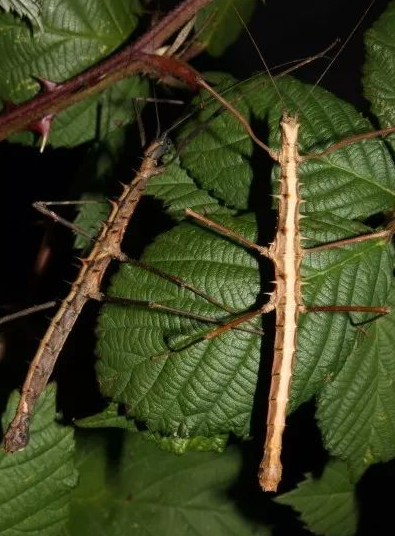Stick Insects: Masters of Stealth
Updated:2024-12-18 Source:Shennongjia National Park
In central China, where Shennongjia meets the Qinling-Daba Mountains, lies a landscape of verdant peaks shrouded in ethereal mist. Over a billion years, natural evolution has fostered a diverse array of landforms and a wealth of rare species. Below 900 meters in elevation, warm and humid evergreen broadleaf forests thrive. Subtropical tree species, including Quercus oxyodon Miq., Quercus engleriana Seemen, Sycopsis sinensis Oliv., and Lindera megaphylla Hemsl., form dense canopies that block out the sun over deep valleys. Among the low-lying shrubs, many Rubus leaves bear semi-circular bite marks left by an unknown animal. But who is the culprit? Students of the Shennongjia Ecological Research Team searched for clues all day but found no sign of the mysterious culprit.

To uncover the truth, the team marked their path during the day and returned under the cover of night to investigate. In the stillness of the night, eerie “hee-hee-hee” chuckles from the trees startled the team members. Thankfully, their seasoned guide reassured them, explaining that the sounds came from flying squirrels and posed no threat. Following their daytime markers, the team quickly arrived at the Rubus bushes. Flashlights, like searchlights, scanned the shrubs methodically—from left to right, top to bottom. At last, they found the culprit behind the damaged leaves.
It turned out that the semi-circular marks on the leaves were made by stick insects. During the day, they hide deep within the shrubs, but at night, they wobble their way onto the leaves to feast. These nocturnal herbivores are remarkably cunning. Not only do they resemble twigs, but when startled, they quickly extend their front legs, fold their middle and hind legs close to their bodies, and freeze in place. In this pose, they look exactly like a small branch, blending seamlessly into their surroundings, making it nearly impossible to distinguish them from the real thing.
In addition to using mimicry and camouflage to evade predators, stick insects also adopt behavioral defenses. They simulate wind-blown twigs or even sacrifice limbs to escape threats from birds, spiders, and other predators. With their convincing disguise, stick insects have managed to survive in the fiercely competitive natural world, earning their reputation as the ultimate masters of stealth in the Shennongjia forest.
In the Shennongjia region, stick insects are colloquially known as “dry twigs” and are rumored to be venomous. There’s even a local saying: “Bitten in the morning, buried by evening.”(Written by Chen Jin) Copyright Shennongjia National Park
Address:36 Chulin Road, Muyu Town, Shennongjia Forestry District, Hubei Province 鄂ICP备18005077号-3
Address:36 Chulin Road, Muyu Town, Shennongjia Forestry District, Hubei Province 鄂ICP备18005077号-3
Email:2673990569@qq.com
Phone:0719-3453368
Phone:0719-3453368


TOP

